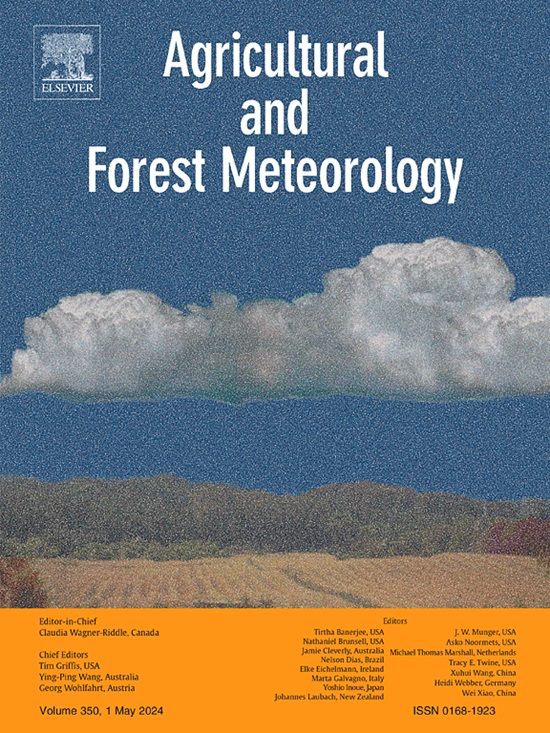Ecosystem-atmosphere exchanges of carbon dioxide, water vapour and energy in India: A synthesis of insights from eddy covariance measurements
IF 5.7
1区 农林科学
Q1 AGRONOMY
引用次数: 0
Abstract
India is a large country characterised by diverse bioclimatic regions and semi-natural and managed ecosystems, with some of the largest areas of arable land and mangroves, globally. Eddy covariance represents the state-or-the-art for directly quantifying the exchange of mass and energy between land surface and atmosphere. Here, we collate eddy covariance flux observations from several sites across India, covering major land use and vegetation types and spanning twenty-seven site-years. The pattern of maximum and minimum CO2 exchange differ widely among the sites and ecosystems. Croplands exhibit maximum CO2 uptake during the monsoon in response to rainfall. Some forests, croplands, and mangroves behave as well-watered ecosystems, whereas others oscillate between well-watered and water-stressed states, due to temperature and moisture dynamics. Respiration changes commensurately with photosynthetic CO2 uptake, primarily comprising growth respiration. Grasslands have a higher carbon retention capacity, followed by croplands, forests, and mangroves. CO2, water, and sensible and latent heat fluxes peaked during different times of the day across ecosystems, imprinting phase-lags that vary by site and season. Water-limited ecosystems register the highest ecosystem water use efficiency (WUE), whereas the irrigated croplands have the lowest WUE. Forests have intermediate WUE of these two; however, Indian forests (predominantly tropical and subtropical) have lower WUE than their temperate and boreal counterparts. Canopy-atmosphere coupling is tightest during the dry periods, with their physiological controls regulating the properties of the surface atmosphere. This is reversed during the monsoon when environmental control dominates physiological control. This information is essential for the long-term monitoring of these ecosystems and climate studies and will be useful to different communities, including scientists, economists, resource managers, and policymakers.

印度二氧化碳、水蒸气和能量的生态系统-大气交换:涡流相关方差测量的综合见解
印度是一个以多样的生物气候区和半自然和管理的生态系统为特征的大国,拥有一些全球最大的耕地和红树林。涡旋相关方差代表了直接量化地表与大气之间质量和能量交换的最新技术。在这里,我们整理了来自印度多个站点的涡动相关通量观测,涵盖了27个站点年的主要土地利用和植被类型。不同场址和生态系统的最大和最小CO2交换模式差异很大。在季风期间,农田对降雨的响应显示出最大的二氧化碳吸收量。一些森林、农田和红树林表现为水分充足的生态系统,而另一些则由于温度和湿度的动态变化而在水分充足和缺水状态之间摇摆。呼吸作用随光合作用CO2吸收而相应变化,主要包括生长呼吸作用。草地的碳保持能力较高,其次是农田、森林和红树林。在生态系统中,二氧化碳、水、感热和潜热通量在一天中的不同时间达到峰值,这在不同的地点和季节留下了不同的相位滞后。水资源限制型生态系统的水资源利用效率最高,而灌溉农田的水资源利用效率最低。森林的WUE介于两者之间;然而,印度森林(主要是热带和亚热带)的WUE低于温带和北方森林。在干旱时期,冠层-大气耦合最为紧密,其生理调控调节着地表大气的特性。在季风期间,当环境控制主导生理控制时,情况正好相反。这些信息对于这些生态系统和气候研究的长期监测至关重要,对包括科学家、经济学家、资源管理者和政策制定者在内的不同群体都很有用。
本文章由计算机程序翻译,如有差异,请以英文原文为准。
求助全文
约1分钟内获得全文
求助全文
来源期刊
CiteScore
10.30
自引率
9.70%
发文量
415
审稿时长
69 days
期刊介绍:
Agricultural and Forest Meteorology is an international journal for the publication of original articles and reviews on the inter-relationship between meteorology, agriculture, forestry, and natural ecosystems. Emphasis is on basic and applied scientific research relevant to practical problems in the field of plant and soil sciences, ecology and biogeochemistry as affected by weather as well as climate variability and change. Theoretical models should be tested against experimental data. Articles must appeal to an international audience. Special issues devoted to single topics are also published.
Typical topics include canopy micrometeorology (e.g. canopy radiation transfer, turbulence near the ground, evapotranspiration, energy balance, fluxes of trace gases), micrometeorological instrumentation (e.g., sensors for trace gases, flux measurement instruments, radiation measurement techniques), aerobiology (e.g. the dispersion of pollen, spores, insects and pesticides), biometeorology (e.g. the effect of weather and climate on plant distribution, crop yield, water-use efficiency, and plant phenology), forest-fire/weather interactions, and feedbacks from vegetation to weather and the climate system.

 求助内容:
求助内容: 应助结果提醒方式:
应助结果提醒方式:


